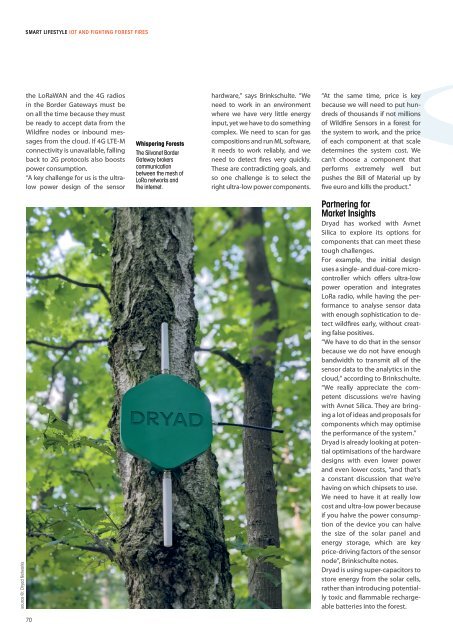Smart Industry No.1 2022
Smart Industry No.1 2022 - The IoT Business Magazine - powered by Avnet Silica
Smart Industry No.1 2022 - The IoT Business Magazine - powered by Avnet Silica
Create successful ePaper yourself
Turn your PDF publications into a flip-book with our unique Google optimized e-Paper software.
<strong>Smart</strong> Lifestyle IoT and Fighting Forest Fires<br />
the LoRaWAN and the 4G radios<br />
in the Border Gateways must be<br />
on all the time because they must<br />
be ready to accept data from the<br />
Wildfire nodes or inbound messages<br />
from the cloud. If 4G LTE-M<br />
connectivity is unavailable, falling<br />
back to 2G protocols also boosts<br />
power consumption.<br />
“A key challenge for us is the ultralow<br />
power design of the sensor<br />
Whispering Forests<br />
The Silvanet Border<br />
Gateway brokers<br />
communication<br />
between the mesh of<br />
LoRa networks and<br />
the internet.<br />
hardware,” says Brinkschulte. “We<br />
need to work in an environment<br />
where we have very little energy<br />
input, yet we have to do something<br />
complex. We need to scan for gas<br />
compositions and run ML software,<br />
it needs to work reliably, and we<br />
need to detect fires very quickly.<br />
These are contradicting goals, and<br />
so one challenge is to select the<br />
right ultra-low power components.<br />
“At the same time, price is key<br />
because we will need to put hundreds<br />
of thousands if not millions<br />
of Wildfire Sensors in a forest for<br />
the system to work, and the price<br />
of each component at that scale<br />
determines the system cost. We<br />
can’t choose a component that<br />
performs extremely well but<br />
pushes the Bill of Material up by<br />
five euro and kills the product.”<br />
source ©: Dryad Networks<br />
Partnering for<br />
Market Insights<br />
Dryad has worked with Avnet<br />
Silica to explore its options for<br />
components that can meet these<br />
tough challenges.<br />
For example, the initial design<br />
uses a single- and dual-core microcontroller<br />
which offers ultra-low<br />
power operation and integrates<br />
LoRa radio, while having the performance<br />
to analyse sensor data<br />
with enough sophistication to detect<br />
wildfires early, without creating<br />
false positives.<br />
“We have to do that in the sensor<br />
because we do not have enough<br />
bandwidth to transmit all of the<br />
sensor data to the analytics in the<br />
cloud,” according to Brinkschulte.<br />
“We really appreciate the competent<br />
discussions we're having<br />
with Avnet Silica. They are bringing<br />
a lot of ideas and proposals for<br />
components which may optimise<br />
the performance of the system.”<br />
Dryad is already looking at potential<br />
optimisations of the hardware<br />
designs with even lower power<br />
and even lower costs, “and that's<br />
a constant discussion that we're<br />
having on which chipsets to use.<br />
We need to have it at really low<br />
cost and ultra-low power because<br />
if you halve the power consumption<br />
of the device you can halve<br />
the size of the solar panel and<br />
energy storage, which are key<br />
price-driving factors of the sensor<br />
node”, Brinkschulte notes.<br />
Dryad is using super-capacitors to<br />
store energy from the solar cells,<br />
rather than introducing potentially<br />
toxic and flammable rechargeable<br />
batteries into the forest.<br />
70
















